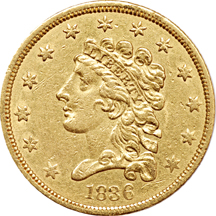The Collector's Auction
< Previous
Lot
281
Next >
| Choose Category: |
|
|
|
|
|
|
|
Please Note: A 15% Buyers' Premium is added to the hammer price of all lots in this sale.
|
(About The Images)


|
|
Lot Title:
|
1836 AU-50.
|
|
Description:
|
A popular type, this pale yellow-gold specimen has a meager array of contact ticks. A dainty pattern of hairlines is perceived on its reverse, along with a minute shiny patch underneath the Eagle's left wing. The deign motifs are prominently detailed.
This lot may contain an item not certified by ANACS, PCGS, or NGC. While Scotsman Auction Co. is typically conservative in our descriptions of items not certified by one of these companies, we cannot guarantee our grading estimation will match their grade. We highly recommend that collectors seeking items certified by a third-party grading service only bid on items that have already been certified. No lot can be returned because of a variance in judgment with regards to grade.
|
|
Low Estimate:
|
$900.00 |
|
High Estimate:
|
$1,100.00 |
|
Lot Status:
|
Bidding has been closed for this lot. |
|
Hammered Price: |
$975.00
|
|
Price Realized:
|
- |
|


Price history for items of the same classification:
| Lot # | Auction | Current Bid or Hammer Price | Description |
| 711 | The Midwest Winter Sale on 02/12/2010 | $475.00 |
|
1836 AU/scratched.
|
|
Plush, multi-hued gold tone drapes beautifully across both sides, providing a desirable two-tone color scheme for this early gold coin. Weak central striking definition could deceive the observer... |
|
| 893 | The Collectors' Auction 2008 on 10/17/2008 | $425.00 |
|
1836 and 1843-O quarter-eagles. VF, cleaned.
|
|
Surreptitious cleaning has had little effect on the patina of these quarter eagles, and indeed, both look original except under the most critical observation. The 1836 "block 8" has VF-35 details, and... |
|
| 894 | The Collectors' Auction 2008 on 10/17/2008 | $525.00 |
|
1836 XF.
|
|
This charming example from this short-lived series projects a yellow-gold surface quality. Insignificant contact ticks are noted, and one nick is observed directly above the first star. In addition... |
|
|